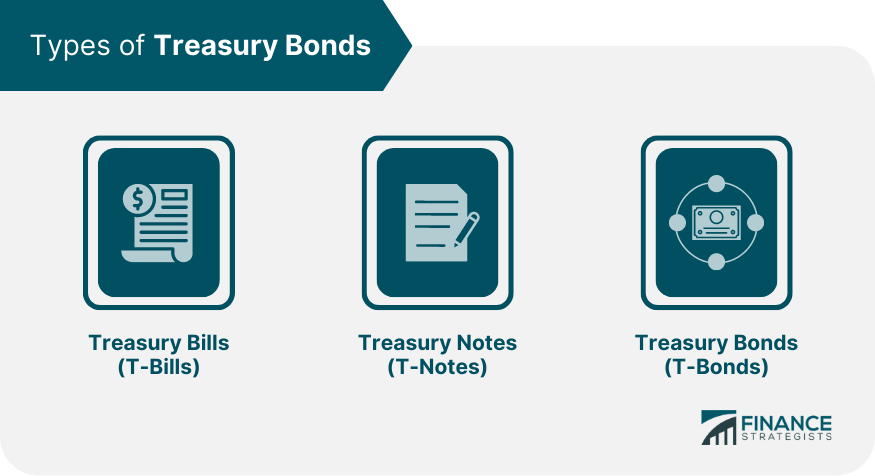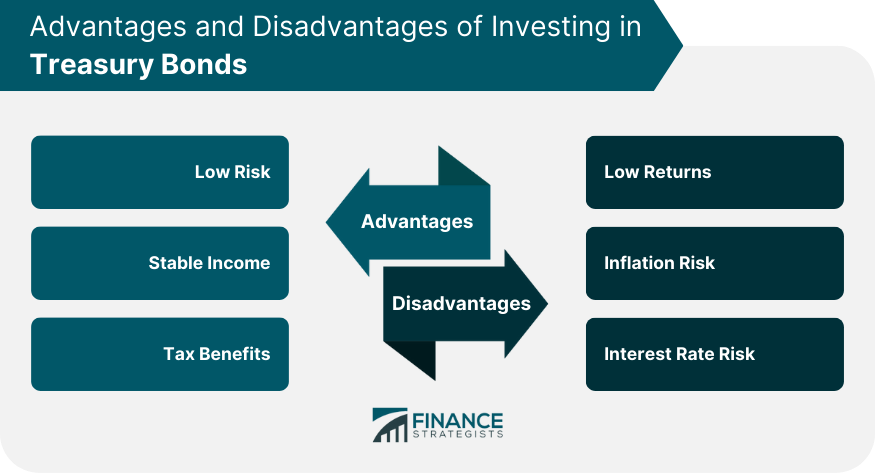A Treasury bond, or T-bond, is a long-term debt security issued by the U.S. Department of the Treasury. These bonds are backed by the full faith and credit of the U.S. government, making them one of the safest investments available. Investors who purchase Treasury bonds receive periodic interest payments, also known as coupon payments, until the bond reaches maturity, at which point the principal is returned to the bondholder. Treasury bonds play a crucial role in the global financial market, providing governments with a reliable source of funding for various public projects and expenses. Additionally, they serve as a benchmark for interest rates and are used by investors to assess the risk of other investments. Treasury bonds are considered a crucial component of a well-diversified investment portfolio, as they can offer stability and income with minimal risk.
Treasury bonds typically have long-term maturities, ranging from 10 to 30 years. The maturity of a bond has a significant impact on its risk and return profile, with longer-maturity bonds generally offering higher yields but also being more sensitive to interest rate changes. The coupon rate is the annual interest payment made to the bondholder, expressed as a percentage of the bond's face value. Treasury bonds typically pay a fixed coupon rate, which remains constant throughout the bond's life. The coupon rate influences the bond's yield and overall return potential. The yield of a Treasury bond is the annual rate of return on the bond, taking into account the coupon payments and any change in the bond's price. The yield fluctuates based on market conditions, interest rates, and investor demand for the bond. Investors often compare the yields of different bonds or bond types to assess their relative attractiveness. Treasury bonds have the highest credit rating due to their backing by the U.S. government. Credit rating agencies, such as Standard & Poor's and Moody's, assign ratings to bonds based on their perceived credit risk. The high credit rating of Treasury bonds reflects their low risk of default and the strong creditworthiness of the U.S. government. Treasury bills (T-bills) are short-term debt securities with maturities ranging from a few days to 52 weeks. T-bills do not pay a fixed coupon; instead, they are sold at a discount to their face value and mature at their full face value. The difference between the purchase price and the face value represents the return on the T-bill. Treasury notes (T-notes) are intermediate-term debt securities with maturities ranging from two to 10 years. Like T-bonds, T-notes pay a fixed coupon rate at regular intervals, typically semiannually, and their principal is returned at maturity. T-notes offer a balance between the shorter maturities of T-bills and the longer maturities of T-bonds. Treasury bonds, or T-bonds, are long-term debt securities with maturities of 10 to 30 years. These bonds pay a fixed coupon rate, typically semiannually, and return their principal upon maturity. T-bonds are suitable for investors seeking long-term, stable income with minimal risk. Interest rates have a significant impact on Treasury bond prices, as higher interest rates can cause existing bonds with lower yields to become less attractive, leading to a decline in their prices. Conversely, falling interest rates can cause bond prices to increase, as existing bonds with higher yields become more attractive to investors. Understanding the relationship between interest rates and bond prices is essential for investors when evaluating the potential risks and returns of Treasury bonds. Inflation can also affect Treasury bond prices, as rising inflation can erode the purchasing power of fixed-income investments. When inflation expectations increase, investors may demand higher yields to compensate for the loss of purchasing power, resulting in lower bond prices. Conversely, lower inflation expectations can lead to higher bond prices, as the real value of the fixed interest payments becomes more attractive. Economic conditions can influence Treasury bond prices through their impact on interest rates and inflation expectations. In times of economic uncertainty or weakness, investors often seek the safety of Treasury bonds, increasing demand and pushing bond prices higher. On the other hand, during periods of strong economic growth, investors may shift their assets to riskier investments, leading to lower demand and falling bond prices. Government policies, such as fiscal and monetary policies, can impact Treasury bond prices. For example, expansionary fiscal policies, such as increased government spending or tax cuts, can lead to higher inflation expectations and potentially higher interest rates, which may negatively affect bond prices. Conversely, contractionary fiscal policies can have the opposite effect. Monetary policies, such as changes in the federal funds rate or quantitative easing, can also influence interest rates and, in turn, Treasury bond prices. Treasury bonds are considered one of the safest investments available, as they are backed by the full faith and credit of the U.S. government. This low risk makes them an attractive option for conservative investors seeking capital preservation and a stable source of income. Treasury bonds provide a stable source of income through their regular coupon payments, which are typically paid semiannually. This predictable income can be particularly appealing to investors seeking a reliable source of cash flow, such as retirees or those looking to supplement their income. The interest income generated from Treasury bonds is exempt from state and local income taxes, which can provide a tax advantage for investors. However, the interest is still subject to federal income tax. This tax benefit can make Treasury bonds more attractive to investors in high-tax states or those seeking tax-efficient income sources. Due to their low risk, Treasury bonds typically offer lower returns compared to other investments, such as stocks or corporate bonds. This lower return potential may not be sufficient to meet the long-term financial goals of some investors or to keep pace with inflation. As fixed-income investments, Treasury bonds are subject to inflation risk, which is the potential for rising inflation to erode the purchasing power of the bond's interest payments and principal. Investors should consider the potential impact of inflation on their investment returns and may need to incorporate other assets into their portfolio to help mitigate this risk. Treasury bonds are exposed to interest rate risk, as changes in interest rates can impact bond prices. When interest rates rise, bond prices generally fall, which can result in capital losses for investors who need to sell their bonds before maturity. Investors should be aware of this risk and consider their investment time horizon and risk tolerance when investing in Treasury bonds. Investors can purchase Treasury bonds directly from the U.S. Department of the Treasury through the TreasuryDirect website. This method allows investors to buy bonds at their initial auction without paying any commissions or fees. Treasury bonds can also be purchased through a broker or financial institution, which may offer additional services, such as research and advice, but may also charge commissions or fees for their services. Investors should carefully compare the costs and benefits of purchasing Treasury bonds through a broker versus directly from the government. Another option for investing in Treasury bonds is through mutual funds or exchange-traded funds (ETFs) that invest primarily in Treasury securities. These funds provide investors with instant diversification and professional management, but they may also charge management fees and other expenses. Investors should carefully consider the costs, benefits, and potential tax implications of investing in Treasury bonds through mutual funds or ETFs. Treasury bonds are long-term debt securities issued by the U.S. government, providing a stable and low-risk source of income for investors. They have various characteristics, such as maturity, coupon rate, yield, and credit rating, which can affect their risk and return profile. There are different types of Treasury bonds, including Treasury bills, Treasury notes, and Treasury bonds, each with their unique features and investment horizons. Investing in Treasury bonds has its advantages, such as low risk, stable income, and tax benefits, but it also comes with disadvantages, such as low returns, inflation risk, and interest rate risk. Investors have several options for investing in Treasury bonds, including direct purchase from the government, purchase through a broker, or investing in mutual funds or ETFs. By carefully considering the characteristics, advantages, and disadvantages of Treasury bonds, investors can determine whether they are a suitable addition to their investment portfolio based on their individual financial goals and risk tolerance.What Is a Treasury Bond (T-Bond)?
Characteristics of Treasury Bonds
Maturity
Coupon Rate
Yield
Credit Rating
Types of Treasury Bonds
Treasury Bills (T-Bills)
Treasury Notes (T-Notes)
Treasury Bonds (T-Bonds)

Factors Affecting Treasury Bond Prices
Interest Rates
Inflation
Economic Conditions
Government Policies
Advantages of Investing in Treasury Bonds
Low Risk
Stable Income
Tax Benefits
Disadvantages of Investing in Treasury Bonds
Low Returns
Inflation Risk
Interest Rate Risk

How to Invest in Treasury Bonds
Direct Purchase From the Government
Purchase Through a Broker
Purchase Through Mutual Funds or ETFs
Final Thoughts
Treasury Bonds (T-Bonds) FAQs
A Treasury Bond (T-Bond) is a long-term debt security issued by the U.S. Treasury Department with a maturity period of 10 to 30 years.
Treasury Bills (T-Bills) have maturities of up to 1 year, Treasury Notes (T-Notes) have maturities between 1 to 10 years, while Treasury Bonds (T-Bonds) have maturities of 10 to 30 years.
Treasury Bonds are considered low-risk investments with stable income and tax benefits. They are backed by the full faith and credit of the U.S. government.
The main disadvantage of investing in Treasury Bonds is the potential for low returns compared to other investment options. They are also exposed to inflation and interest rate risks.
You can invest in Treasury Bonds by buying them directly from the government, purchasing them through a broker, or investing in mutual funds or ETFs that hold Treasury Bonds in their portfolios.
True Tamplin is a published author, public speaker, CEO of UpDigital, and founder of Finance Strategists.
True is a Certified Educator in Personal Finance (CEPF®), author of The Handy Financial Ratios Guide, a member of the Society for Advancing Business Editing and Writing, contributes to his financial education site, Finance Strategists, and has spoken to various financial communities such as the CFA Institute, as well as university students like his Alma mater, Biola University, where he received a bachelor of science in business and data analytics.
To learn more about True, visit his personal website or view his author profiles on Amazon, Nasdaq and Forbes.















